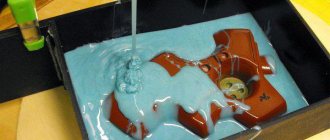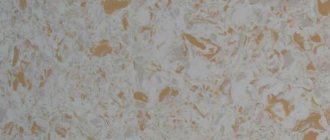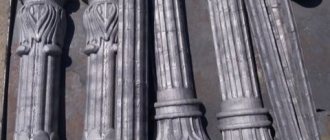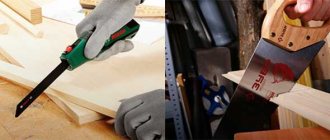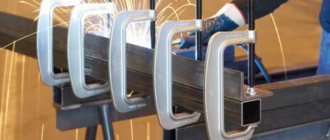Features of gypsum
Gypsum is considered a unique material that is easily processed and can take any shape. Almost any figure can be made from liquid plastic plaster. After hardening, the product looks especially beautiful.
When dry plaster is combined with water, a mass is obtained that is similar in consistency to dough. It hardens quickly and retains its given shape perfectly. As the solution hardens, it expands slightly and generates a small amount of heat. This feature is very important. The fact is that the expanding plaster begins to fill all the recesses, repeating the shape with maximum accuracy.
Another important property of gypsum is its environmental friendliness. So, to prepare the base for modeling, you only need dry plaster and plain water. Ease of use and environmental friendliness have made gypsum especially popular.
Various architectural decorations, decorative elements, and figures are made from plaster. To create products, special molds are used. They are made from wood, cement, plastic, epoxy resin, plasticine, and metal. But silicone molds for pouring plaster are considered the most convenient and practical to use. They are in great demand and allow you to create unique gypsum products.
Useful tips
Follow all the rules for working with gypsum and the sequence of technological steps. Very often, problems in working with this simple material arise when the sculpture manufacturing technology is violated. Be sure to thoroughly dry the products after removing them from the mold and only then proceed with their further design. Try using different shapes to make sculptures. Any small figurines, children's toys and household items are suitable as samples for their manufacture. Using the technique described, you can make impressions of your hands at home. Making sculptures from plaster is an interesting and accessible form of creativity for everyone!
What is a silicone mold for plaster
Silicone molds have many advantages. Firstly, the gypsum solution does not stick to its surface. This is very important because the integrity of the product is not compromised. Thus, gypsum crafts cast in silicone molds have an ideal appearance. No other material has such properties. Secondly, the silicone mold for plaster is very elastic and wear-resistant. It can be used many times without compromising its integrity. Thirdly, the silicone mold is easily separated from the frozen product. This means that the silicone plaster mold does not require lubrication before pouring. This is very convenient for craftsmen and greatly simplifies their work.
How to restore plaster garden figures
Gypsum or alabaster are not strong enough materials; when impacted, from humidity and frost, they easily crack and lose color. In such cases, you can carry out the restoration yourself:
- Small chips can be eliminated by applying gypsum putty to the damaged area. After drying, this part is painted, varnished and decorated in the same way as the entire figure. You can repaint the entire craft;
- When the figure is broken in half, it is easy to glue it back together. If additional pieces were broken off, they are first fixed with waterproof glue, and then the halves of the figurine are fastened together. The joint is coated with putty, tinted, and varnished;
- Scratches on the figurine are removed with putty. After it has dried, the surface is re-tinted and varnished;
- The cracked varnish is carefully peeled off with fine sandpaper and a new layer is applied with a brush.
Multi-colored snails will easily complement a Japanese bonsai or flower bed
How to make a silicone mold for plaster
Ready-made silicone molds can be purchased at hardware stores. But you can make it yourself. In this case, the master has the opportunity to create a form according to his own creative idea.
The production of silicone molds for plaster is carried out using a certain technology.
First you need to make a container for filling. For this you can use wood, chipboard, fiberglass and any other material. Or you can take a ready-made container. Then you should carefully glue the parts of the mold so that they hold well and there are no gaps.
At the next stage, you need to take sculptural plasticine and evenly lay out up to half of the container. This should be done carefully so that the surface is smooth and free of defects.
Then you need to place a model in plasticine for which the mold is made. It is very important to make small holes in the plasticine with a pencil so that parts of the mold do not move during casting.
Now you need to measure the volume of silicone required. You can calculate the amount of material needed based on the size of the container.
Then you need to lubricate the surface of the model with a soap solution or wax lubricant. To create silicone, you need to mix a liquid solution of silicon dioxide and an acid hardener according to the instructions on the package and pour the mixture in a thin stream onto the plasticine with the model. Once the top of the mold has hardened, you can remove the plasticine. But this should be done carefully so as not to damage the surface of the mold.
Now you need to lubricate the surface of the model and the mold again, prepare the silicone mass and make a mold for the upper part of the model.
The silicone mold for plaster is ready.
Manufacturing of gypsum molds for casting
Casting in plaster molds requires a certain skill, good planning and precise coordination of the master's actions. How to make a casting mold from plaster?
First, a flask is built around the model of the future product - a box made of cardboard covered with tape, or hard plastic. The gaps between the base and the walls are coated with plasticine. The model is coated with lubricant and placed inside the flask at equal distances from the bottom and walls. Pieces of plastic and cardboard are used as supports. Sometimes they simply hang the model by strings.
Gypsum is diluted to the consistency of sour cream
Gypsum is diluted to the consistency of sour cream and applied with a brush to complex relief elements of the model - corners, depressions, etc. Everything is ready for casting. Then the model is poured to the line where the flask halves meet and the plaster is left to thicken.
Plaster casting mold
After thickening, check how well the model separates from the lower half, lubricate it and the model, and fill the upper half of the mold. After the upper half has thickened, holes are drilled in the corners for pins that will secure the halves during casting. After this, the upper half is removed and the model is removed. The flask is ready for casting. If you are a beginner, plan on ample time to gain experience and develop skills. Casting in plaster may not work the first time.
Cost of ready-made silicone molds
Today, many companies produce ready-made silicone molds for plaster. The price for them, depending on complexity and size, ranges from 200 rubles and above. So, for a simple form for decorating a room in the form of a shell or leaf, you need to pay 290–320 rubles. More complex, larger shapes cost significantly more. For example, the price of a mold for making decorative stone ranges from 900 to 1,500 rubles per square meter. m. There are intermediaries who offer silicone molds made in China at wholesale prices.
Features of caring for garden plaster decorations
If the manufacturing and processing technology is followed, plaster figurines will last for many years, but proper care is integral to preserving the appearance of the products. Therefore, you should consider:
- when cold weather sets in and the air temperature drops to below zero, as well as during prolonged rains, you need to remove garden figurines from the garden for storage in a warm and dry room;
- It is best to place the figures on a base made of natural stone or concrete, which will prevent insects from being exposed to moisture near the base;
- The varnish on the figures should be renewed every 2 or 3 years, which will protect the color of the products.
Proper care is the key to maintaining the bright color of plaster figures
Crafts from plaster for the New Year
On the eve of the upcoming holidays, various toys and decorations for the home and Christmas tree appear on store shelves.
And for those who are interested in creativity, it will not be difficult to make New Year’s candlesticks and lanterns, openwork snowflakes and stars with additional plaster decor.
Working with plaster is interesting, simple and exciting, it can be a complex and attention-consuming process of making stucco or holiday decorations.
Everyone will find interesting ideas in such needlework and will want to independently implement a project for making decor for their home or garden.
Selecting a figure
The variety of gypsum stucco today is not limited to the creation of figures of thick-cheeked cupids, graceful lines of flowers and petals, and indoor cornices. Using this material, you can create an imitation of a fireplace, “grow” a tree on a vertical wall surface or on the ceiling. The figure can be classically white or painted in various colors. The choice is determined by the wishes of the customer.
First of all, you need to decide on the appearance of the future work of art, its size, and location. The best option is to make a natural-size stencil or apply a design to the surface that you plan to decorate.
The options are endless. The simplest ones are stars, flowers, snowflakes, letters. You can decorate the room with original three-dimensional paintings - landscapes, still lifes. A “carved” frame will allow you to achieve complete imitation.
Solution
Preparation of gypsum solution For casting large gypsum products, the solution is prepared in small portions. The thick solution does not flow well and does not completely fill the mold, which has a thin relief.
An adhesive solution – gelatin or flesh solution – can slow down the hardening reaction. Recommended 25% con. It must be used within one day. In addition, the use of an adhesive solution gives the products strength.
Flat products are ground to a flat surface sprinkled with fine gypsum flour and left there for a day.
Decorative stucco as an integral element of the interior
The use of stucco in the interior has not lost its relevance and popularity for several centuries. In modern conditions, it is actively used when decorating premises not only in classical styles or when creating Empire, Baroque interiors; it can even be appropriate in minimalist high-tech, but, of course, subject to the use of other lines and shapes.
In the construction market, in addition to gypsum products, materials made from polyurethane and expanded polystyrene have also gained wide popularity. Wood products are also traditional, although their cost is much higher.
Despite the fact that buying ready-made elements for creating stucco molding does not present any problem, in order to create a truly unique interior, many owners prefer individual production.
Of course, it’s easiest to independently produce stucco molding to decorate walls and ceilings if you have drawing skills, since you first need to make an accurate sketch, drawing out all the lines and elements especially carefully.
But, if you have ideas, you can contact a specialist who will do this part of the work. And you can do the actual manufacturing, including preparing the molds, yourself.
In addition, it should be borne in mind that stucco foam, despite the fact that it is a mass-produced product, if you have some artistic taste, it may well become the basis for interior decoration.
Using different types of elements and combining them with each other, you can create original and beautiful compositions. Also, stucco molding from this material is often used as a finishing accent when decorating walls in a room, neatly separating zones from each other.
The advantages of this material include its affordable price, long service life and ease of installation. Polyurethane stucco, which is often used when decorating modern rooms, has similar characteristics. Considering that both of these materials are moisture resistant, they can be actively used in rooms with high humidity and temperature changes.
In addition to the fact that stucco molding performs an aesthetic function, its use can also have a purely utilitarian function, for example, to visually hide some unevenness, cracks and other surface defects.
If used correctly in such cases, they will fit in as organically as possible, giving the interior an additional touch of nobility or sophisticated charm.
Painting plaster crafts
Before you start painting, you need to start treating the surface of the workpiece, for which special compounds are used.
After sanding off excess irregularities and removing dust from the workpiece, it is covered with putty, which ensures good adhesion of the paint and improves hygroscopicity.
Powder and other paints are used for painting; you can cover the surface of the product with them manually.
If the craft is quite voluminous and has many details, it is easy to use special spray systems or paint and varnish materials in cylinders.
Small details and elements that require drawing are performed using the technique of manual paint application.
Before this, it is best to draw the boundaries of the image with a pencil and light lines, and try to paint as carefully as possible, without going beyond the contours of the details.
Materials and tools for making crafts
To make a product of any shape and size from gypsum, you must first prepare the mixture itself.
To mix liquid and powder, it is better to use an old and unnecessary container, and be sure to follow the basic recommendations for working with the resulting mass:
- mixing is carried out once in the proportions indicated on the packaging; after drying, the gypsum cannot be reused;
- Dry powder is poured into the container first, it is necessary to make a recess in it and fill in the required amount of liquid;
- water can be poured in portions, which will help simplify the procedure of stirring and removing lumps of dry powder;
- When mixing, it is necessary to achieve maximum homogeneity of the resulting mass, for which you can use a construction mixer.
In order to create various plaster crafts, you may need molds and cuttings, additional material for creativity.
These can be silicone molds, homemade frames made of durable materials, mineral and natural materials that help recreate a certain texture.
Gypsum crafts for home
In the home interior, all kinds of decorative products that you can create with your own hands are often used.
Gypsum is used to make stands for jewelry, voluminous frames for photos and mirrors, holders for books and paperweights, vases with exquisite decor, New Year's or holiday toys, and even stucco molding.
Decorative plaster house
A small house made using standard technology from gypsum mortar will help to please your child.
But such a craft will look best if it is based on the idea of a non-standard candlestick, and a night light with a candle inserted inside is used in a nursery or living room, or on a holiday table.
Plaster hand
It is customary to store keys and most frequently worn jewelry in vases or boxes, but you can also make a stand from plaster.
The prepared solution is poured into the glove, when the composition sets, it can be given any shape, and after drying, the material is carefully cut and the craft can be coated with paint.
Ideal material for stucco molding
If stucco molding is made by hand, then the most suitable material for this is gypsum. Among its advantages are:
- natural origin of the material;
- hypoallergenic;
- inertness to various microorganisms;
- moisture resistance;
- fire safety.
In addition, working with it is not at all difficult, although you will have to perform all operations as quickly as possible, since it hardens within 5-7 minutes and completely loses its plasticity after another 5 minutes.
Among the obvious disadvantages, attention should be paid to its rather large weight, which requires careful selection of adhesive compositions for installation, as well as its fragility. In the interior, stucco molding made from gypsum can be used to decorate ledges, columns, fireplace portals, create original reliefs on the walls or rosettes on the ceiling, etc.
Gypsum crafts for the garden
DIY gypsum gardening ideas help decorate your landscape; you can install gypsum flowerpots and stands in your garden and grounds.
Geometric shapes look interesting, replacing decorative benches and used for practical zoning of space.
Garden mushrooms made of gypsum
Another garden craft made from cement and plaster are mushroom figurines that can replace traditional gnomes.
Using the same pattern modeling technique, they work on products in the shape of snails and frogs, ladybugs and even plaster flowers, which are fixed on bushes or trees in the garden.
Gypsum leaves
Unusual shapes for plaster figures are created using natural materials such as leaves of living plants.
It is best to choose large sheet plates for work with prominent and textured veins, which are sure to be imprinted on the surface of the finished product.
Gypsum flower boot
Original gypsum crafts for the garden look unusual, and one of the types of plant pots can be a boot.
Old shoes are thoroughly washed and placed in a container into which a plaster solution is poured. After preparing the workpiece, it is cleaned and the procedure is repeated, and a plastic bottle is used for removal.
Pros and cons of stucco in the interior
Nowadays, with the help of this type of wall decoration, it is possible to add volume to small rooms and give them the proper style. Plaster stucco decorations, placed proportionally on the walls, will easily correct the shape of the rooms. The so-called moldings will allow you to visually change the room and hide existing shortcomings. And how elegant an openworked niche in the wall or your favorite fireplace looks.
As mentioned, stucco is made from gypsum or polymer materials, and wooden decor is also used. But finishing with wood is a very expensive procedure, although it carries with it irreplaceable, environmentally friendly qualities. A much more economical material is polyurethane. It is durable and reliable, does not cause allergies in humans.
The advantages of gypsum stucco are its ability to penetrate even a small hole or crack. Since when it hardens, it has the property of expansion.
Modern manufacturers offer a wide selection of ready-made designs. It is enough to fix them with liquid nails, sealant or strong glue to create an exquisite design.
What are the disadvantages of stucco? The main problem with gypsum molding is the large mass of parts and, in comparison with polyurethane stucco, a higher price. Gypsum is a rather fragile material.
The disadvantage of polyurethane is its lack of durability, the release of toxic substances when heated, and sometimes inherent deformation. It is better not to use if there are people in the family who are susceptible to allergies. If the damage is serious, it is almost impossible to repair this product.
There is an assertion that this polymer material adequately replaces its more expensive gypsum counterpart, but polyurethane is not able to convey all the lines and transitions in the scenery as well as gypsum.

